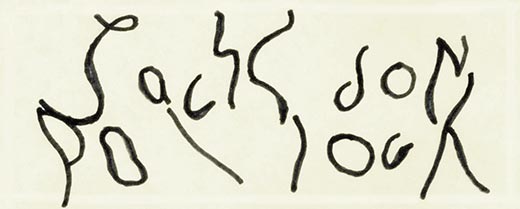Jackson Pollock was an Abstract-Expressionist painter. He went to New York and studied at the Art Student League. Pollock was an alcoholic, and he went into therapy. However, Pollock was unwilling to share his problems with the therapist, so it had little effect in helping him. This rehabilitation experience nevertheless affected Pollock’s works. Pollock died of an alcohol-related car crash when he was 44.

Pollock’s works consisted of action paintings, works that are characterized by the dripping and pouring of paint directly on the canvas. He did not paint using an easel, but instead painted using the floor for which he was quoted saying that he needed the resistance of a hard surface. He also said that painting on the floor enabled him “to be a part of the painting”, because he could walk around it and paint on all four sides. The photographer Hans Namuth documented Pollock while working in his studio.
Photographs of Jackson Pollock working in his studio by Hans Namuth



It may be a good bet to say that for the casual art viewers (in contrast with art enthusiasts), deciphering the meaning of most of the abstract paintings produced is a difficult thing to do. With the artist’s philosophies, expressions, and feelings all contained on the canvas, interpreting the meaning of the work may seem like taking a look at someone’s countless and kaleidoscopic thoughts. On the other hand, representational works such as the ones in the Renaissance and Baroque Eras can easily be given an interpretation by most people.
These abstract paintings...


vs.

The ambiguous and vague nature of abstract-expressionist paintings allows the artist to conceal messages that people cannot easily see. Pollock might have done this to his painting entitled, Mural.
Can you see something?

The Smithsonian website has an article I have read just recently that talks about the alleged hidden name of Jackson Pollock painted in camouflage on his work, the Mural. The author of the article mentioned that it was his wife who first saw the letters “S-O-N” on the upper right area of the mural, “Then she realized JACKSON ran across the entire top. And finally she saw POLLOCK below that.”

http://www.smithsonianmag.com/multimedia/videos/Find-Pollocks-Name.html
It should be noted that this discovery is just a theory because of the lack of scientific evidences. Sue Taylor, an art historian from the Portland State University and who also has studied Pollock’s work the Stenographic Figure, said that “It’s feasible. Pollock would often begin with some sort of figurative device to which he would then respond—and eventually bury under layers of paint. Letters and numbers, moreover, frequently appear in works of the early 1940s."




















































BOOYAH